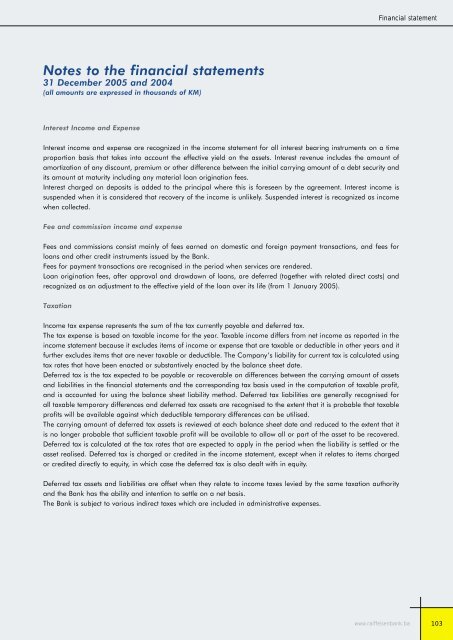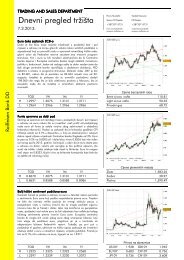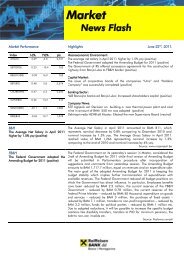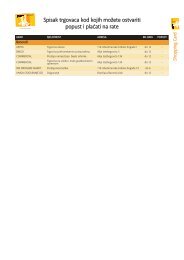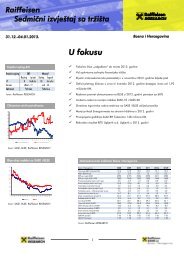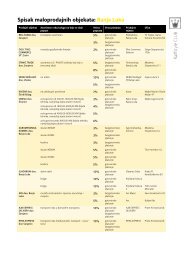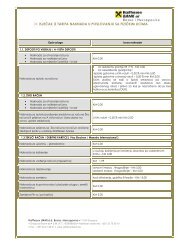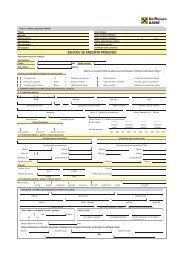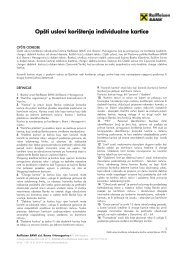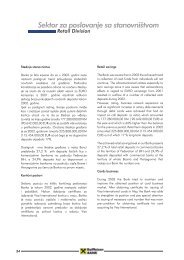Bilansi uspjeha - Raiffeisen Bank
Bilansi uspjeha - Raiffeisen Bank
Bilansi uspjeha - Raiffeisen Bank
You also want an ePaper? Increase the reach of your titles
YUMPU automatically turns print PDFs into web optimized ePapers that Google loves.
Notes to the financial statements<br />
31 December 2005 and 2004<br />
(all amounts are expressed in thousands of KM)<br />
Interest Income and Expense<br />
Interest income and expense are recognized in the income statement for all interest bearing instruments on a time<br />
proportion basis that takes into account the effective yield on the assets. Interest revenue includes the amount of<br />
amortization of any discount, premium or other difference between the initial carrying amount of a debt security and<br />
its amount at maturity including any material loan origination fees.<br />
Interest charged on deposits is added to the principal where this is foreseen by the agreement. Interest income is<br />
suspended when it is considered that recovery of the income is unlikely. Suspended interest is recognized as income<br />
when collected.<br />
Fee and commission income and expense<br />
Fees and commissions consist mainly of fees earned on domestic and foreign payment transactions, and fees for<br />
loans and other credit instruments issued by the <strong>Bank</strong>.<br />
Fees for payment transactions are recognised in the period when services are rendered.<br />
Loan origination fees, after approval and drawdown of loans, are deferred (together with related direct costs) and<br />
recognized as an adjustment to the effective yield of the loan over its life (from 1 January 2005).<br />
Taxation<br />
Income tax expense represents the sum of the tax currently payable and deferred tax.<br />
The tax expense is based on taxable income for the year. Taxable income differs from net income as reported in the<br />
income statement because it excludes items of income or expense that are taxable or deductible in other years and it<br />
further excludes items that are never taxable or deductible. The Company’s liability for current tax is calculated using<br />
tax rates that have been enacted or substantively enacted by the balance sheet date.<br />
Deferred tax is the tax expected to be payable or recoverable on differences between the carrying amount of assets<br />
and liabilities in the financial statements and the corresponding tax basis used in the computation of taxable profit,<br />
and is accounted for using the balance sheet liability method. Deferred tax liabilities are generally recognised for<br />
all taxable temporary differences and deferred tax assets are recognised to the extent that it is probable that taxable<br />
profits will be available against which deductible temporary differences can be utilised.<br />
The carrying amount of deferred tax assets is reviewed at each balance sheet date and reduced to the extent that it<br />
is no longer probable that sufficient taxable profit will be available to allow all or part of the asset to be recovered.<br />
Deferred tax is calculated at the tax rates that are expected to apply in the period when the liability is settled or the<br />
asset realised. Deferred tax is charged or credited in the income statement, except when it relates to items charged<br />
or credited directly to equity, in which case the deferred tax is also dealt with in equity.<br />
Deferred tax assets and liabilities are offset when they relate to income taxes levied by the same taxation authority<br />
and the <strong>Bank</strong> has the ability and intention to settle on a net basis.<br />
The <strong>Bank</strong> is subject to various indirect taxes which are included in administrative expenses.<br />
Financial statement<br />
www.raiffeisenbank.ba<br />
103


